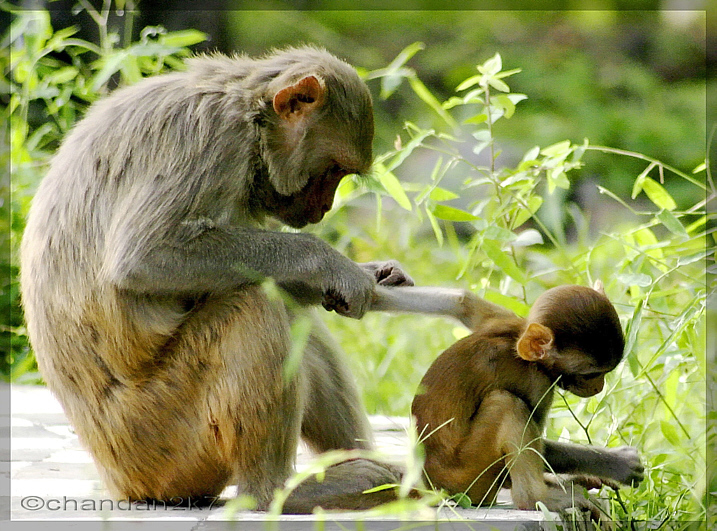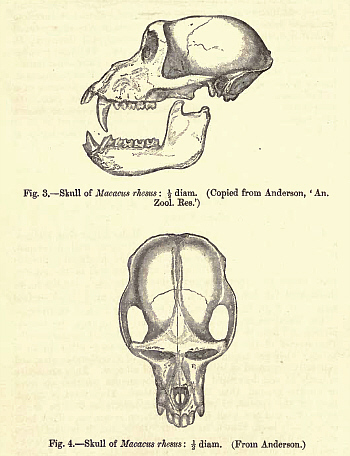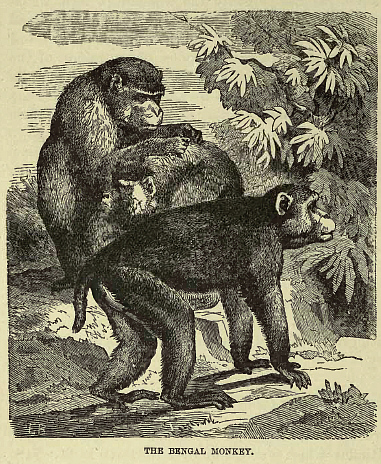

Zitierweise / cite as:
Carakasaṃhitā: Ausgewählte Texte aus der Carakasaṃhitā / übersetzt und erläutert von Alois Payer <1944 - >. -- Anhang B: Tierbeschreibungen. -- Macaca mulatta. -- Fassung vom 2010-12-10. -- URL: http://www.payer.de/ayurveda/tiere/macaca_mulatta.htm
Erstmals publiziert:
Überarbeitungen:
Anlass: Lehrveranstaltung SS 2007
©opyright: Dieser Text steht der Allgemeinheit zur Verfügung. Eine Verwertung in Publikationen, die über übliche Zitate hinausgeht, bedarf der ausdrücklichen Genehmigung des Verfassers
Dieser Text ist Teil der Abteilung Sanskrit von Tüpfli's Global Village Library
WARNUNG: dies ist der Versuch einer
Übersetzung und Interpretation eines altindischen Textes. Es ist keine
medizinische Anleitung. Vor dem Gebrauch aller hier genannten Heilmittel wird
darum ausdrücklich gewarnt. Nur ein erfahrener, gut ausgebildeter ayurvedischer
Arzt kann Verschreibungen und Behandlungen machen!
Falls Sie die diakritischen Zeichen nicht dargestellt bekommen, installieren Sie eine Schrift mit Diakritika wie z.B. Tahoma.
Verwendete und zitierte Werke siehe: http://www.payer.de/ayurveda/caraka000b.htm

Abb.: Rhesusaffen = Macaca mulatta , Rajgir, Bihar
[Bildquelle:
scorius. --
http://www.flickr.com/photos/scorius/750037346/. -- Zugriff am
2007-07-15. --
![]()
![]()
![]() Creative
Commons Lizenz (Namensnennung, keine kommerzielle Nutzung, keine
Bearbeitung)]
Creative
Commons Lizenz (Namensnennung, keine kommerzielle Nutzung, keine
Bearbeitung)]

Abb.: Schädel des Rhesusaffen
[Bildquelle: Blanford 1888/91]
Lydekker:
"THE BENGAL
MONKEY (Macacus rhesus).Perhaps the best known of all the macaques is the common Bengal or rhesus monkey, the bandar of the Hindus, which is found all over Northern India.

This monkey presents but little resemblance to the last species, having no trace of a beard or a ruff, and its colour being brown, with a tinge of grey. As a species it is characterised by the straightness of its moderately long hair, and also by the buttocks being naked for some distance round the callosities. The tail is about one-half the length of the head and body, and tapers regularly from base to tip, without any trace of a terminal tuft. The face, as well as the callosities on the buttocks, are flesh-coloured, except in the adults, when they are bright red.
In India the Bengal monkey is found continuously northward from the valley of the Godaveri to the Himalaya, extending to the west coast at Bombay. It inhabits the valley of Kashmir and surrounding regions, at elevations of and above four thousand feet. In the neighbourhood of the hill sanitarium of Simla these monkeys are found at an elevation of between eight and nine thousand feet above the sea-level ; and it is one of the regular expeditions from Simla to ride or walk to see the monkeys on their own hill, which rejoices in the appropriate name of Jako. Here they are regularly fed by a fakir, who has taken up his abode on the same mountain, and they come down in troops at his well-known call. Indeed, these monkeys are almost invariably found in large droves ; usually in the forests or more cultivated lands, but occasionally near and in the towns. Although not regarded as sacred, it appears that the rhesus monkey is frequently protected by the Hindus, and in Kashmir the writer has seen them forming part and parcel of the appanages of the temples. In several parts of India the Hindus have, indeed, a strong objection to the slaughter of these monkeys.
The rhesus is an intelligent creature, and, if captured young, is docile and easily taught. It is the common monkey carried about by itinerant jugglers in Northern India, by
whom it is taught many amusing tricks. Old animals, more especially males, become vicious and spiteful.In their wild state these monkeys make a hideous noise with their incessant chattering, and they are always mischievous.
In addition to the consumption of large quantities of fruit and seeds, they also subsist on insects and spiders, and parties of them
may frequently be seen carefully searching the ground for these delicacies. Mr. Blanford tells us that the rhesus, like the crab-eating macaque, swims well, and takes readily to the water.Professor Ball relates a curious anecdote of these monkeys : "
When at Malwa Tal [near the Himalayan Station of Naini Tal], which is one of the lakes where I spent a day, I was warned that, in passing under a landslip which slopes down to the lake, I should be liable to have stones thrown at me by monkeys. Regarding this as being possibly a traveller's tale, I made a particular point of going to the spot in order to see what could have given rise to it. As I approached the base of the landslip on the north side of the lake, I saw a number of brown monkeys (M. rhesus) rush to the sides and across the top of the slip, and presently pieces of loosened stone and shale came tumbling down near where I stood. I fully satisfied myself that this was not merely accidental ; for I distinctly saw one monkey industriously, with both forepaws, and with obvious malice prepense, pushing the loose shingle off a shoulder of rock. I then tried the effect of throwing stones' at them, and this made them quite angry, and the number of fragments which they then set rolling was speedily doubled. This, though it does not actually amount to throwing or projecting an object by monkeys as a means of offence, comes very near to the same thing, and makes me think that there may be truth in the stories of their throwing fruit at people from trees."It is probable that the Bengal monkey ranges to the north-east into Assam and Upper Burma, and thence into the province of Yunnan, in Western China. In Szechuen, and eastwards into the interior, it is replaced by the closely allied Chinese rhesus (M. lasiotis).
Another nearly related species is the Himalayan macaque (M. assamensis), found at considerable elevations in the Eastern Himalaya, Assam, the Mishmi Hills, and parts of Upper Burma. According to Mr. Blanford it is distinguished from the Bengal monkey by the wavy nature of the hair, which in the Himalayan specimens assumes a decidedly woolly texture. Dr. Anderson tells us that it is larger than the last-named species, and more powerfully and compactly built, and thus approaches the under-mentioned pig-tailed monkey. Mr. Blanford further observes that, whether wild or tame, it is more sluggish in its movements than the Bengal monkey ; and also that there is a slight difference between the voice of the two species."
[Quelle: Lydekker, Richard <1849-1915>: The royal natural history / edited by Richard Lydekker ; with preface by P.L. Sclate. -- London ; New York : F. Warne, 1893-96. -- 6 Bde. : ill. (some col.) ; 26 cm. -- Bd. 1. -- S. 113 - 115. -- Online: http://www.archive.org/details/royalnaturalhist01lyderich. -- Zugriff am 2007-09-27]
Blanford:
"Although this monkey is not regarded as sacred by Hindus, it is never molested by them, and in many parts of the country it is as impudent as the Hanuman and even more mischievous. Very intelligent, and, when young, fairly docile, it is one of the commonest animals kept tame, and throughout Northern India it is the monkey carried about by itinerant showmen, and taught to perform tricks of various kinds. It is a most amusing creature, the incarnation of mischief and curiosity, but frequently rather ill-tempered. Older individuals are usually savage. In the wild state it is found in herds, often of considerable size. It has generally but little fear of man, and may occasionally be found in native villages, though less commonly than the Hauuman. It is very frequently seen on the ground searching for food, and it eats spiders and many kinds of insects, especially Lepidoptera and Orthoptera, besides fruits and seeds. Flocks of this monkey are more frequently seen near cultivation, especially around tanks or amongst trees on the banks of streams, than in forest jungle. These animals are very quarrelsome, perpetually screaming and fighting, or teasing each other in fact, they behave very much like unruly children.
M. rhesus swims well and takes readily to water."
[Quelle: Blanford, W. T. <1832 – 1905>: Mammalia. -- 1888 - 1891. -- (Fauna of British India including Ceylon and Burma). -- S. 14. -- Online: http://www.archive.org/details/mammalia00blaniala. -- Zugriff am 2007-09-06]